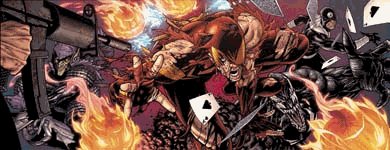Reviewers: Robert Cammarata, Kevin Jones, Phil Hunn & Jason Grasso.
Editor: Stephanie Kay
Introduction by Stephanie Kay
Mark Millar has won over many admirers with his work on the major Marvel event Civil
War. He has also ruffled many feathers in its alternative depictions of
iconic characters and in-team disputes. But controversy and confliction sells,
there's no doubt, and an eargly anticipated issue has arrived with further
side-choosing and side swapping. Comixfan proudly spotlights the latest issue,
along with a variety of reviewer-receptions.
Story Title: Civil War Part 5
Writer: Mark Millar
Penciller: Steve McNiven
Inker: Dexter Vines
Letterer: Chris Eliopoulos
Colorist: Morry Hollowell
Production: Kate Levin
Assistant Editors: Molly Lazer & Aubrey Sitterson
Editor: Tom Brevoort
Editor In Chief: Joe Quesada
Publisher: Dan Buckley
Published by: Marvel Comics
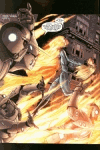
Reviewer #1: Robert Cammarata
Civil War # 5 returns this week to no doubt dominate the sales
charts and divide the comic community in half in much of the same way as the
heroes of its tale. If you loved this book or hated this book prior to this weekís
issue I highly doubt your opinion has changed. Civil War #5 continues
steady on its path to an eventual conclusion but takes the reader merely a baby
step into that pivotal direction. It has its fair share of pros, but
unfortunately like its leading controversial "antagonist" Tony Stark,
this book continues to be infuriating, difficult to support and unjustifiably
arrogant.
This issue sees detractors from both camps in the "war," some internal
and physical battles waged and a few surprises to boot. However, with the hype
being what itís been and the sheer scope of this story, itís clear to see
how this issue has come up short. I mentioned battles and they are in here.
However, this is a war. A war is constant, unforgiving and unavoidable. If we
were talking about Civil War #4 Iíd say this idea of war was
right at the forefront with visceral violence coming from Millarís words and
McNivenís pictures and the fall of a larger than life (literally) hero to top
it all off. In the wake of this kind of drama and fallout Iím surprised with
the amount of discussing, meeting and general restraint that most characters
show in this issue. There are vague references here or there to some sort of
plan of attack from both sides in the struggle and the word "final
battle" pops up from time to time but it all seems very much abstract. I
would have welcomed this type of plotting and this kind of a large-scale
planning from earlier issues but this is a chapter 5 of 7. The time for
discussion is over and full out pummeling should be commencing. Both sides spent
much of this issue in their trenches prepping for war when in a chapter 5 of 7
many should be out in "no manís land" taking the fight to the other.
I get that issue 4 had a very wide scale fight and that the next issue probably
should offer a bit of relief but this book is very rapidly winding down and like
I mentioned, in a war there is no time for relief. War is constant and the bulk
of the players (not SHIELD rent-a-cops or cameos of heroes) should be constantly
engaged in this warfare. Captain America remarks at one point, "Quiet,
Cage. Iím thinking." Iím afraid at this point in the story Steve, you
shouldnít have that luxury.
Now, donít get me wrong as there is action in this story and the scenes
featuring Spidey fighting for his life are written and particularly drawn to
great effect. My complaint is with the whole scale of this action. The fight
scene(s) featuring Spider-man filled most of the "war" quota of this
issue but it should have been supported with similar phenomenon throughout. What
might be at fault here is the basic layout of the comic. Pictures and scenes are
drawn on a very big scale. This works in some cases, especially considering the
scope of this event, but using large panels to depict talking heads scenes also
takes up extra space when a smaller layout for these scenes would suffice. This
type of large panel layout and emphasis on the almighty splash page limits the
amount of content that can be conveyed in a single issue.
I think Iíve been spoiled by some of the great work Ed Brubaker has been
producing for Marvel because the smaller panel layout he has his artists work
with on books like Daredevil and Criminal really
allow for intensity at times but also a lot more room to build a proper plot and
flesh out characters and themes. At one point in Civil War #5 the
reader is really beginning to sink their teeth into the story and then there is
this really inappropriate and almost irrelevant double page spread of the
superhero prison, which many readers are already familiar with, and the storyís
space is all but over. That type of use of the splash page is a serious problem
in many comics today. Splash pages are like exclamation points. Use them
sparingly for emphasis but use them too much or at inopportune moments and they
make your work look ridiculous. A two-page spread for that visual? Half a page
tops in my book and thatís being generous.
Now that Iíve spent on some time on the bad I want to tackle the good, because
believe it or not, itís in here too. You cannot put the names Mark Millar and
Steve McNiven on a title and not have some positives to "moan" about,
if you will. Millar does a great job building tension throughout this issue. The
confrontation between Tony and Peter is well written and marks a fairly
consistent interpretation of Peterís character. Most of the dialogue works
well, again at establishing a particular tone or suspenseful feeling and Millar
is successful throughout in making the reader sympathize deeply with the
detractorsí unique situations. The art, as typical, is nothing short of
gorgeous. McNiven uses a wide array of paneling techniques and positions to draw
out the conflicts plaguing Spidey in this issue. Again, the reader feels true
empathy for Peter and his plight. The art also does a phenomenal job of really
crystallizing and illustrating the prescient emotions of each character in the
depictions of their facial expressions. Faces are a difficult, yet essential
part of any graphic story and McNiven and company have this art of the emotive
face down to a science.
Possibly the strongest visual in the entire issue is a single page spread (used
very appropriately) that reveals the return of a character. This image is
absolutely breathtaking. However, due to some quite blatant hints over the
course of the issue in both the writing and art this reveal is so in your face
obvious that the beautiful page spread is almost relegated moot due to the
failure of the reveal to be of any consequence. In a similar instance, and all
the credit to him, Millar actually takes his first baby step to giving the now
infamous Tony Stark a single, shred of humanity. Millar actually has a few lines
of dialogue that actively seek to push forward Starkís POV. Now, I think this
is a worthwhile task and personally, in many ways, I can see the sequence of
events since Stamford from Tonyís perspective. However, in the four issues
prior, the sheer volume of time making the pro-reg forcesí actions deplorable
and building up the anti-reg resistance makes this type of "balancing
act" a bit hard to buy at this stage in the game.
I get the feeling another writer might be able to pull it off, but Millar is way
too self-conscious in his writing to properly display the pro reg argument in
any persuasive way. At one point, Reed (looking very remorseful in his facial
expression thanks to McNiven) remarks, "Do you ever stop to think how much
easier things would be if we hadnít spliced Thorís DNA with Hank Pymís
Cyber Tech? If we didnít have this big final battle planned with all those
thunderbolt lunatics? Hank wouldnít be doped-up on anti-depressants and my
darling Sue would never have left." First of all, super-smart, genius Reed
is only now pondering if creating a practically omnipotent god-clone hybrid and
working with sociopaths might have been a bad choice? In the words of a younger
generation, DUH! Reed thinks of this now? Was he not sitting in on the meeting
when these choices were made? And as for the anti-depressants line, it is hard
to see things from the pro-reg standpoint when they are clearly written as being
in the wrong; doubting themselves and resorting to drugs to numb the pain of
their own idiotic and unethical actions. Could the pro reg have been represented
fairly and balanced in this story? I think so. Have they been? Even the
characters themselves seem to know the answer to this one.
And so there you have it. Clearly, Civil War #5 is not my favorite
book of the year. However, with some work and the eventual culmination of Millarís
plot there is still some hope for this story.





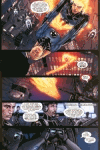
Reviewer #2: Kevin Jones
Say what you will about Civil War, but there's no doubt that it's
a hell of a lot of fun. This is really a big-budget action movie we're talking
about. And in order for a big-budget action movie to be good, it's got to knock
you out of your seat, which is exactly what this series has done so far. Mind
you, nobody wants a movie like Armageddon on their hands, and that's why the
writing has to be sharp and avoid insulting our intelligence at all costs.
Whatever criticism you may have of Millar's writing style, it succeeds in this
goal as well.
McNiven's art is as striking as ever, and always gives you something interesting
to look at. Even his panels of people standing around doing nothing are
dramatic. There's a sort of kinetic energy that keeps going throughout each
issue, and that's a nice feat five issues in. But at the same time, he's able to
pull off a couple of moment-to-moment panel transitions (is that a red dot on
your shoulder?). I'm impressed with the way he's handled the sheer number of
characters in this crossover (it makes me understand the delays.) Even with such
a huge cast, each character is drawn with the same amount of care. If anything,
I'd say the art is a little sterile at times, but that's nitpicking. The art
here has given me a hankering to pick up some back issues of Marvel
Knights 4.
So Spider-Man's finally changed sides. We all knew this months ago, right? Even
Agent Hill knew. The big question is whether it was handled well, and I'm sure
there will be vastly different opinions. I say yeah, it was handled right, but
that doesn't stop me from needing to see more in Amazing Spider-Man
next week. His confrontation with Iron Man is satisfying after all that's gone
down so far. After that point...well, poor Spidey gets the same Millar treatment
as in his Marvel Knights book. Mark Millar seems to think it's fun to beat up on
this poor guy. Spider-Man does come across as a little inept in his escape,
which I'm sure we can chalk up to having an incredibly bad day. It's making me a
little anxious to see Spider-Man do something right in this series.
For the record, I'm pro-registration, and I'm glad that Iron Man says a few
convincing words about his stance this time around. It seems like Millar has
been trying a little too hard to make the anti-reg side more sympathetic. This
makes me think that the whole thing is misdirection, and it'll be Tony's side
which comes out on top. Reed expresses some regret over what's he's done, and it
comes across quite smoothly from how he's portrayed in FF in the
recent issue. He's talking like a man who's discovering that personal feelings
might be more important than the most compelling facts. In other words, there's
plenty of development on the pro-reg side for a change.
Now, I don't think Millar is a god. Some things don't come through with the same
impact he thinks they have, like finding out who the ski-mask guy was. Was I the
only one who yawned at that revelation? Sometimes characters do seem like
they're being crammed into the plot heavy-handedly. I'm annoyed that Tony has
gone from saying that 42 is permanent, to saying it's only temporary. And he
says them both to the same person. It would've also been nice if the
different artists trying to render that prison would have tried to make their
renditions look similar, at least. Okay, sure, it's from a different angle, it's
at a different stage of construction; but it feels inconsistent.
When all is said and done, the positives outweigh the negatives for me. I'm
enjoying how so many characters are getting quality screen time. I like how you
can understand the story completely just reading the core series, but it
actually makes you want to read the tie-ins. Now it's time to gear up for
the final battle, and I'm excited to see how it plays out. The most important
goal for a project like this is to get people interested and make them want to
find out what happens, and it's certainly worked on me.





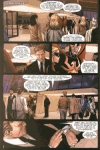
Reviewer #3: Phil Hunn
Anybody else getting flashbacks to House Of M yet?
As the fifth chapter of Civil Warís central miniseries closes,
weíre really still no nearer to getting any real resolution to any of the
seriesí plots than we were after Clone-Cyborg Thor beat the crap out of, and
then killed, Goliath last issue. Instead the story plods along with only a
couple of major plot developments listed in the twenty-two pages -- with the
pro-registration side still being made to look like unrepentant Nazi
thugs (Iron Man, particularly, is now looking like the worldís biggest
tin-clad arsehole). Hell, this issue sees the anti-registration side being made
to look even more like desperate Robin Hood types against the amoral and
vicious tactics of Tony Starkís crew than they were last time around. This
issue brings the only real bit of possible ambiguity to Captain Americaís
not-so-merry band thatís been seen since the start of the series. And the fact
that itís only possible ambiguity works against the book spectacularly
-- whereís the definitive statement? Whereís the one-two punch that says
"there is an end in sight?" Itís not there.
This is not how the fifth chapter of a seven-issue miniseries should be going.
Thereís less sitting around and thumb-twiddling than there was in Bendisí
aforementioned mutant misfire, but still, the snailís-pace plotting is not
doing anybody any favours -- least of all the readers. At this point we should
be seeing Captain America actively taking the fight to Iron Manís cronies on
some level other than piecemeal raids and table-based discussion, ready for
something other than a rushed conclusion over the next couple of issues. The
battering ram should be smashing down the walls of the castle by now, but all itís
actually doing is simply trundling leisurely towards its target while its
operators sit on its edges and watch the world go by.
This is what weíve experienced those heinous delays for? Itís a massive
disappointment, to say the least. Fortunately, the artwork by Steve McNiven is
still top-drawer stuff, with some dynamic action sequences. Unfortunately, those
are rather spoiled by the over-abundance of splash pages -- again, at this point
the art should be concerned less with Giant Freakiní Exclamations and more
with actually getting on and telling the story. In the time it takes to show
some of those splash pages we could have been getting the plot shoved along,
which this miniseries sorely needs. And Iím still smarting from Marvelís
idiotic decision to hang its entire comics schedule for months to come on
McNiven not being late with his pages for this issue. He was. And now Marvel is
in big trouble because of it.
Had he not had so many bloody great splash pages to draw, I think he might have
made it, and people like my retailer wouldnít be looking daggers at Marvel
right now.
I want to say Iím impressed with a lot of this issue, I really do (Spider-Manís
parts of the story are very well-done, for instance). But the unpleasant reality
of the situation is that I canít, because itís just not yanking the story
forwards as much as it could do -- and walking in place at this stage is not a
good idea.
Disappointing.
OVERALL:





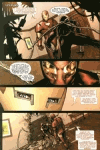
Reviewer #4: Jason Grasso
Civil War #5 doesn't deliver any shocking revelations a la Thor's
supposed return or Spider-Man's unmasking but itís still a good read. Itís
hampered by some serious storytelling flaws which prevent this from really being
considered a great title. But there is a lot to like here, particularly
Spider-Manís obvious turn and Punisherís entrance into the fray.
The issue opens with a dramatic escape by the Invisible Woman and Human Torch
from S.H.I.E.L.D. agents and quickly cuts to a showdown at Stark Tower between
Iron Man and Spider-Man. Both events are wonderfully illustrated by Steve
McNiven (check out the shot of Iron Man getting tossed through the wall, and the
whole sequence with Spidey by the window). Unfortunately both events are not
logical lead-ins based on the events that ended last issue. (More on that
later.) Soon Spidey is on the lam from S.H.I.E.L.D. and some of the new
Thunderbolts. He gets some help from the Punisher, who carries the tattered
Spidey back to Capís HQ and essentially chooses their side.
If you blink you will miss the akward revelation that Punisher was in fact the
ski-masked man trailing the team in Civil War #4. Given how they
built up this mysterious character, this was a really poor reveal. Wouldn't it
have been more dramatic to show him saving Peter with the mask on and then have
him pull it off to the heroes? His direct reference to the ski mask in his
dialogue is such an obvious statement to the fans. You can't build up a mystery
like that and reveal it as a passing point within a string of dialogue. That
sort of misstep smacks of making-it-up-as-they-go-along syndrome.
The issue ends with a poorly set up sequence that actually works really nicely.
Daredevil is captured and brought to the prison in the Negative Zone (called
"42"). Stark finally seems to be giving the pro-registration side some
just cause with their fifty-state initiative ("a federal force from coast
to coast"). Daredevil isnít buying it and his use of a silver dollar to
hit Tony with a Judas reference is nicely done, if not a bit over the top (sort
of the point of comic books, though).
Unfortunately, the lead in to Daredevilís capture doesnít really make sense.
In the last frame of the scenes at Capís HQ, you see Daredevil with the rest
of the team. The very next frame takes place in Hellís Kitchen, without any
reference to time passing, and we see DD getting carted off by S.H.I.E.L.D.
(There hasnít been any intent by the creators to involve Matt Murdock in the
mini series, instead keeping with Danny Randís cover for his exiled friend.)
It might seem like ridiculous nitpicking but unfortunately there are enough
flaws to knock the title down a few pegs.
Itís become nearly impossible to review a series like Civil War
without taking into consideration so many of these outside variables. For one,
the idea that the offshoots of this main title are not a necessary read and only
provide extended entertainment is completely and utterly false. After every
issue of the mini series, I feel like I missed something by not reading certain
titles. Sure, Iíve known for months that Spider-Man and Iron Man had finally
come to blows (over in Amazing Spider-Man) but I was left
wondering if I missed something by not reading Fantastic Four.
(Invisible Woman and Human Torch had just left the pro-registration side at the
end of last issue but here they appear to have been with the anti-registration
for some time.) The same can be said about this weekís New Avengers,
which left me wondering if I was supposed to have been reading Iron Man
to understand who that issueís main antagonist was. (This is when Marvelís
abandonment of exposition boxes really comes back to bite them in the rear.)
And as much as Marvel wants to contend that itís about the integrity and
continuity of the project, the delays in this series (and subsequently of the
connected titles) have had a major impact on the fulfillment of the story. Long
delays create a heavier need for each individual issue to deliver a bigger
impact, because of a longer wait and thus, longer hype. Marvel compounds this
problem by their monthly solicits for more and more Civil War-related
titles, continuing to imply how big this thing really is. Iím willing to be
patient because I do like where this story is going but for me, the only logical
resolution is a complete and long-lasting split in the Marvel Universe. Anything
less is going to seem House of M-ish.
Perhaps unfairly, Civil War will ultimately be judged when all is
said and done. That hasnít stopped it from being an enjoyable read from issue
to issue. McNivenís art is top notch, not only the details of the art but his
storyboarding seems right from out of the movies. Millar is clearly having fun
pitting allies against each other, and has really spurred on a great debate
among fans choosing sides (akin to the sort of science vs. faith buzz that the
television show Lost enjoyed when it first started). But there too
many holes. When you strive for greatness, you canít look past the details.
OVERALL:





